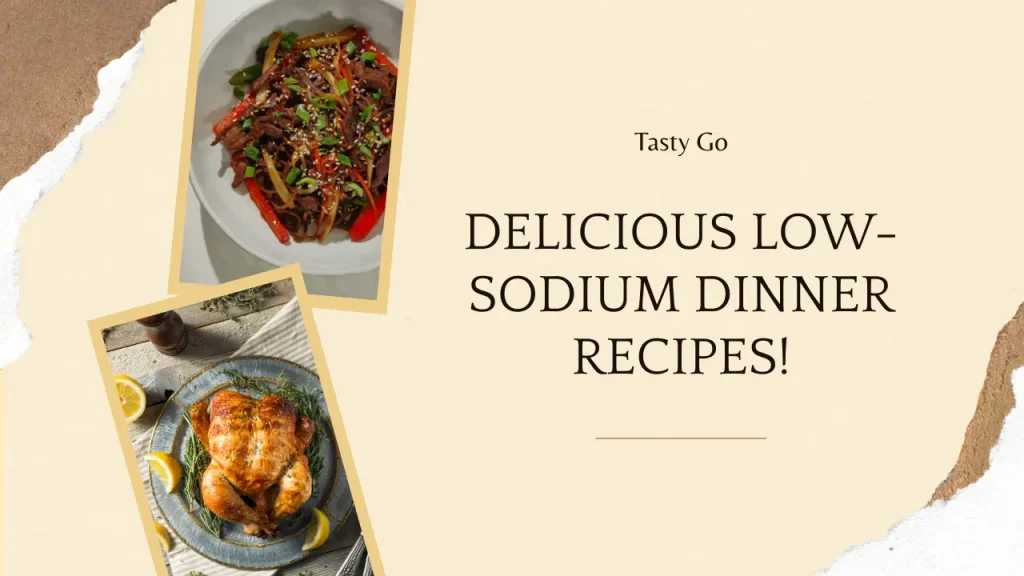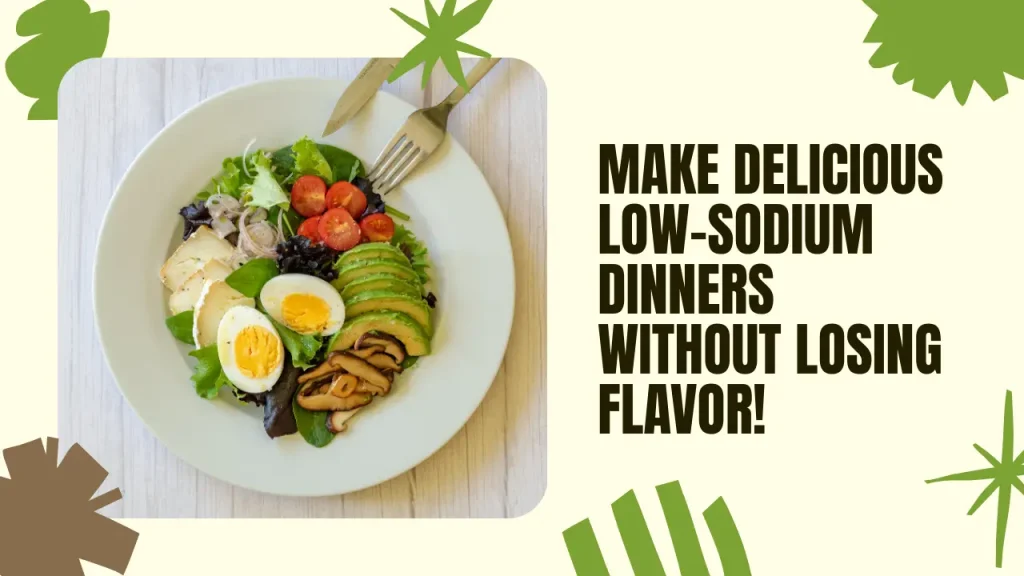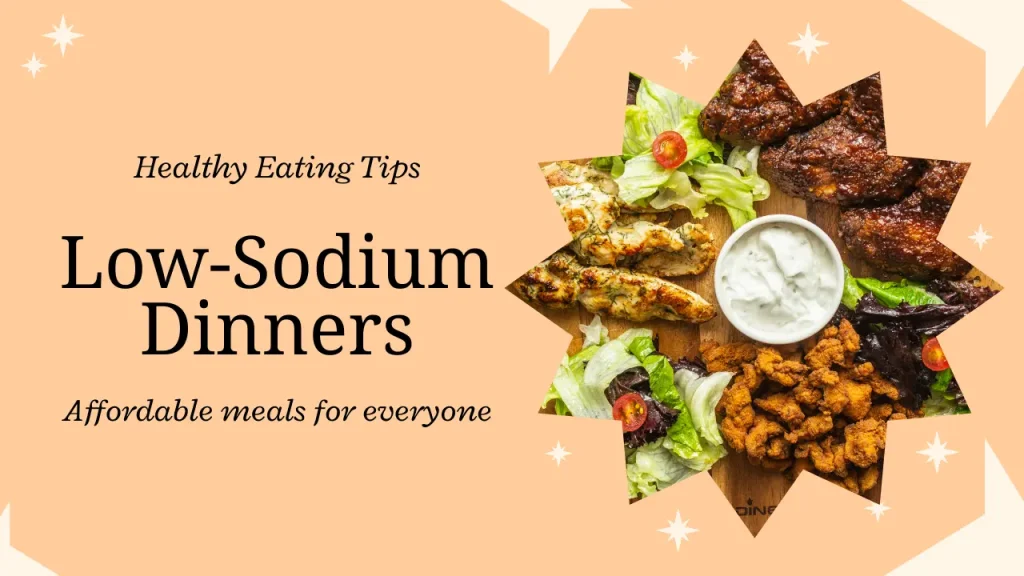Introduction
If you’re trying to manage high blood pressure, support your heart health, or simply eat healthier, reducing your sodium intake is one of the most important steps you can take. But here’s the truth: you don’t have to give up flavor to lower your sodium levels. In fact, low-sodium dinner recipes can be incredibly tasty and satisfying.
Imagine enjoying a flavorful, heart-healthy dinner that’s easy to make, packed with natural ingredients, and leaves you feeling energized — all while helping you manage your sodium intake. Sounds like a win, right?
Let’s uncover the truth about low-sodium dinner recipes and why they should be a part of your healthy eating routine.

What Are Low-Sodium Dinner Recipes?
Low-sodium dinner recipes are meals that minimize the use of salt and sodium-rich ingredients. Instead of relying on excess salt to flavor your dishes, these recipes make use of herbs, spices, garlic, lemon, and other natural flavor-enhancers to create delicious meals. The goal is to reduce sodium intake without sacrificing taste.
The benefits are clear: lowering sodium intake helps manage blood pressure, reduces the risk of stroke and heart disease, and contributes to overall well-being. And the best part? You don’t have to compromise on taste.
Why Should I Follow Low-Sodium Dinner Recipes?
There are a number of compelling reasons to incorporate low-sodium dinner recipes into your daily routine, including:
- Blood Pressure Management: Reducing sodium intake is crucial for managing high blood pressure. High-sodium diets can lead to water retention, which puts additional strain on your heart and blood vessels.
- Heart Health: Lower sodium consumption supports heart health by reducing the risk of heart disease, stroke, and kidney problems.
- Weight Loss: Many low-sodium meals are also lower in processed ingredients and calories, making them an excellent option for those looking to lose weight.
- Better Kidney Function: Reducing salt helps prevent kidney strain, which is especially important for individuals with kidney disease or those at risk.
Can I Still Make Tasty Dinners with Low Sodium?
Absolutely! Low-sodium dinners can be flavorful and satisfying. The key is to focus on natural ingredients that pack a punch of flavor, such as:
- Herbs & Spices: Basil, oregano, thyme, rosemary, and parsley are excellent flavor enhancers that don’t rely on sodium.
- Citrus: Lemon, lime, and orange juice add a burst of flavor to your dishes without any salt.
- Garlic & Onion: These ingredients provide rich flavor that makes it easy to cut back on salt.
- Vinegar & Mustard: Both of these ingredients bring out deep, tangy flavors, perfect for dressings, marinades, and sauces.
With the right combination of ingredients, your low-sodium dinners can be just as delicious as any high-sodium dish.
Examples of Low-Sodium Dinner Options
Wondering where to start? Here are some easy and tasty low-sodium dinner ideas that are packed with flavor:
| Dish Name | Key Ingredients | Sodium Content |
|---|---|---|
| Grilled Chicken with Roasted Vegetables | Chicken breast, olive oil, zucchini, bell peppers, garlic | Very low |
| Quinoa Salad with Beans | Quinoa, black beans, cucumber, olive oil, lemon juice | Very low |
| Salmon with Steamed Greens | Salmon, spinach, garlic, olive oil, lemon | Very low |
| Vegetarian Stir-Fry | Tofu, broccoli, carrots, bell peppers, low-sodium soy sauce | Low |
| Spaghetti Squash with Tomato Sauce | Spaghetti squash, tomatoes, garlic, basil, olive oil | Low |
These dishes are not only low in sodium, but they’re also rich in essential nutrients, making them perfect for a heart-healthy diet.
Can I Use Salt Substitutes in Low-Sodium Recipes?
Yes, salt substitutes can be a great way to enhance flavor in low-sodium recipes. Some popular options include:
- Potassium Chloride: Often found in salt substitutes, potassium chloride can mimic the taste of salt without the harmful effects of sodium. However, be cautious if you have kidney issues, as potassium levels need to be monitored.
- Herb Blends: Pre-packaged salt-free seasoning blends can offer a convenient way to add flavor to your meals without adding extra sodium.
- Lemon or Vinegar: Both add brightness and acidity that naturally enhance flavor, reducing the need for salt.
However, always check with your healthcare provider before introducing new salt substitutes, especially if you have specific health conditions.
Are Low-Sodium Dinners Good for Weight Loss?
Yes! Low-sodium meals are often lower in calories and processed ingredients, making them a great option for weight loss. Here’s why:
- Less Processed Foods: Processed foods are often high in sodium, unhealthy fats, and hidden sugars. By choosing fresh, whole ingredients in your low-sodium dinner recipes, you’re naturally avoiding those unwanted additives.
- Feel Fuller Longer: Many low-sodium meals are rich in fiber and lean protein, which help you feel full and satisfied for longer, reducing the likelihood of overeating.
By making low-sodium dinners a regular part of your diet, you’ll not only support your heart and blood pressure but also create an environment where weight loss is easier to achieve.
Low-Sodium Meal Prep: The Key to Staying on Track
Meal prepping is an effective way to stay on top of your low-sodium diet. Prepping your meals in advance ensures that you always have healthy, sodium-conscious options on hand. Here’s how to make low-sodium meal prep easier:
- Cook in Bulk: Prepare larger portions of lean proteins, vegetables, and grains, then store them in containers for easy access throughout the week.
- Portion Control: Use portion-sized containers for meals to avoid overeating and ensure you’re getting balanced, low-sodium meals.
- Flavor Boosters: Prepare homemade dressings, sauces, and seasonings that are low in sodium and pack a punch of flavor.

How to Make Low-Sodium Dinners More Flavorful
Making low-sodium dinners that taste incredible is all about using creative substitutes and flavor-enhancing ingredients. Here are a few ideas to help:
- Infuse Oils: Try infusing olive oil with herbs like rosemary, thyme, or garlic. It adds a rich depth of flavor to your dishes without extra salt.
- Roast Your Vegetables: Roasting vegetables caramelizes their natural sugars, enhancing their flavor and sweetness, which can reduce the need for added sodium.
- Try Seaweed: Seaweed is naturally salty, so it can be used as a low-sodium alternative in soups and salads.
Low-Sodium Dinner Ideas for Families
If you’re cooking for a family, it can be tricky to create meals that everyone will enjoy, especially when you’re trying to reduce sodium. But it’s totally possible to make low-sodium dinners that are both nutritious and loved by all. Here are some family-friendly low-sodium dinner ideas:
- Turkey Meatballs with Spaghetti Squash: This hearty dish uses lean turkey and is paired with spaghetti squash instead of traditional pasta for a lighter, low-sodium twist.
- Veggie Tacos with Black Beans: Load up soft corn tortillas with seasoned black beans, lettuce, tomatoes, and avocado for a flavorful meal that’s low in sodium and full of fiber.
- Homemade Chicken Fajitas: Skip the sodium-packed fajita seasoning packets and make your own with chili powder, cumin, and garlic. Serve with sautéed peppers, onions, and grilled chicken for a tasty meal.
These ideas are easy to prepare and can be customized to suit your family’s preferences, making it easy to enjoy low-sodium meals together.
How to Read Food Labels for Low-Sodium Ingredients
When cooking low-sodium dinners, it’s important to pay attention to the ingredients you buy. Reading food labels carefully can help you make informed choices when selecting products. Here’s how to read labels for low-sodium ingredients:
- Check the Sodium Content: Look at the “Sodium” line on the nutrition facts label. A food is considered “low sodium” if it contains 140 milligrams or less of sodium per serving.
- Look for “No Salt Added”: For canned vegetables, beans, or tomatoes, choosing products labeled “no salt added” is a great way to reduce sodium.
- Beware of Processed Foods: Many pre-packaged or processed foods, such as sauces, dressings, or frozen meals, can be high in sodium. Opt for fresh or homemade alternatives whenever possible.
- Understand Serving Sizes: Sometimes the sodium content listed is based on a small serving size. Make sure to calculate the total sodium in your portion, especially for foods that are easy to overeat, like crackers or snacks.
By learning how to read food labels effectively, you can ensure your meals stay within your sodium goals while still tasting great.
The Best Low-Sodium Herbs and Spices for Flavor
Flavor doesn’t have to come from salt. In fact, there’s a world of herbs and spices that can make your low-sodium dinners taste extraordinary. Here are some of the best ones to keep in your kitchen:
- Garlic: Fresh garlic or garlic powder adds a bold, savory flavor to any dish, from meats to vegetables.
- Lemon Zest: The zest of a lemon can brighten up any meal, adding freshness without the need for salt.
- Cumin: This spice adds depth to your dishes, perfect for stews, soups, and grain bowls.
- Paprika: Sweet or smoked, paprika is a great way to add rich color and flavor to meats and vegetables.
- Oregano: Often used in Mediterranean and Italian cooking, oregano is perfect for pasta dishes, salads, and roasted vegetables.
Using these herbs and spices allows you to create flavorful low-sodium meals without needing to rely on salt.

Low-Sodium Dinners on a Budget
Eating healthy doesn’t have to be expensive. Low-sodium dinners can actually be quite affordable, especially if you use simple, whole foods. Here are a few tips for creating budget-friendly low-sodium meals:
- Use Affordable Proteins: Chicken breasts, turkey, and canned tuna are all budget-friendly, low-sodium protein options that can be used in a variety of meals.
- Buy Frozen Vegetables: Frozen vegetables are often cheaper than fresh ones and can be just as nutritious. They’re great for soups, stews, and stir-fries.
- Batch Cook: Make large batches of meals like soups or casseroles and freeze them in portions. This saves money and ensures you always have a healthy low-sodium meal on hand.
- Shop for Seasonal Produce: Buy fruits and vegetables that are in season, as they tend to be more affordable and fresher.
By using these strategies, you can enjoy delicious low-sodium dinners without breaking the bank.
Conclusion
The truth about low-sodium dinner recipes is that they are delicious, heart-healthy, and easy to prepare. By reducing sodium in your meals, you’re supporting better blood pressure, improved heart health, and a healthier lifestyle overall. Plus, these recipes are flavorful and satisfying — no need to compromise on taste!
So, are you ready to start cooking heart-healthy, low-sodium meals? Try out some of the recipes above, and experiment with new low-sodium flavor combinations. Your body (and taste buds) will thank you.
FAQs
- What are low-sodium dinner recipes?
Low-sodium dinner recipes are meals that limit the use of salt and sodium-rich ingredients, focusing on herbs and spices for flavor. - Why should I follow low-sodium dinner recipes?
They help manage blood pressure, improve heart health, and reduce the risk of stroke and other health issues related to high sodium intake. - Can I still make tasty dinners with low sodium?
Yes, with the use of herbs, spices, citrus, and garlic, low-sodium dinners can be packed with flavor without needing excessive salt. - What are some examples of low-sodium dinner options?
Grilled chicken with roasted vegetables, quinoa salad with beans, and salmon with steamed greens are great examples. - Can I use salt substitutes in low-sodium recipes?
Yes, potassium chloride and salt-free herb blends can help enhance flavor, but be mindful of your health condition and consult your doctor.

